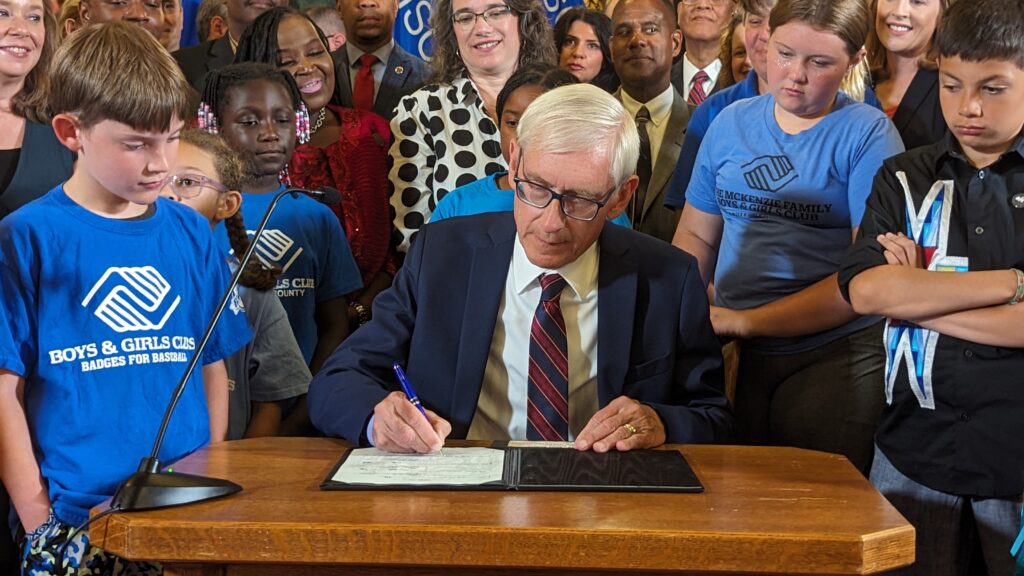Aiming to provide schools ongoing, predictable funding increases, Gov. Tony Evers struck two digits and a dash from the years to extend the annual increases through 2425. Evers signed the 2023-25 budget bill with 51 partial vetoes on July 5, 2023. (Baylor Spears | Wisconsin Examiner)
The Wisconsin Supreme Court heard arguments Wednesday in a case that challenges Gov. Tony Evers’ partial veto that extended school revenue increases for 400 years and questions the limits of expansive power.
The lawsuit challenging the partial veto was brought by Wisconsin Manufacturers and Commerce (WMC), the state’s largest business lobby group, and two Wisconsin taxpayers, Jeffery A. LeMieux, a retired professor, and David T. DeValk, a Fox Valley substitute teacher.
The case centers on a partial veto that Evers exercised in the 2023-25 budget. Lawmakers included a $325 increase to schools’ revenue limits for the 2023-24 and 2024-25 school years in the budget when it was sent to Evers. Aiming to provide schools ongoing, predictable funding increases, Evers struck two digits and a dash from the years to extend the annual increases through 2425.
Scott Rosenow, an attorney for WMC, argued that the Court should strike down Evers’ veto.
“This 400-year veto approaches the absurd and this partial veto power is corrosive to democracy,” Rosenow said, referencing the brief submitted to the court by Richard Briffault, a Columbia Law School legal scholar.
Briffault argued in the brief that allowing veto “creativity” would “further depart from the Constitution’s text, history and structure and its core democratic commitments” and would make Wisconsin an outlier among states with partial veto powers.
Rosenow argued that the veto exceeded the partial veto power established under the state Constitution and created a new word.
“The governor here did not merely delete text. He selectively struck words, digits and a dash to create a new word, so what he did was not like a digit veto that reduces an appropriation by striking a single digit, he created a new word and a new 400-year duration that wasn’t there,” Rosenow said.
Wisconsin has had one of the broadest partial veto powers in the country, though it has been curtailed over the years by constitutional amendments and rulings by the state Supreme Court.
The ‘Vanna White’ veto, which was used by former Gov. Tommy Thompson to strike individual letters to create new words, was eliminated in 1990 by a constitutional amendment. The Legislative Reference Bureau defines this type of veto as striking “phrases, digits, letters, and word fragments so as to create new words, sentences, and dollar amounts.” The language approved by the constitutional amendment stated: “In approving an appropriation bill in part, the governor may not create a new word by rejecting individual letters in the words of the enrolled bill.”
Some of the justices appeared skeptical about the argument that Rosenow was making, saying that the amendments advanced by lawmakers and adopted by voters didn’t specify digits.
“Equally absurd to me is your argument that a letter is a number or vice versa, that a number is a letter…. A fourth grader or dare I say a four-year-old knows the difference between letters and numbers,” Justice Ann Walsh Bradley said. “My response is almost visceral that I don’t care how many fancy words or legal theories you put behind it to make it sound like its erudite four is not a letter of the alphabet.”
Evers’ attorney, Colin Roth, argued that while the veto did extend the date by a significant amount of time, it didn’t violate any previous cases decided by the Court and that it led to “complete and workable law,” a requirement of partial vetoes established under previous case law.
Justices expressed concerns about whether the power continues to be too broad.
“I think that there is concern that now, we’ve got this 402-year veto. It does feel like the sky’s the limit, and perhaps today, we are at that fork in the road, and… we’re trying to think, like, should we today in 2024 start to look at this differently?” Justice Jill Karofsky said.
Roth argued, however, that lawmakers have tools to address the limits of the governor’s ability to shape law, including by passing constitutional amendments and writing legislation in different ways.
“To the extent, your honors do have substantive concerns about the scope of the veto power, those can be addressed in multiple ways. One, a constitutional amendment, it’s not impossible. It’s happened twice. Both times the Legislature has put it to a vote, it’s passed,” Roth said. A second constitutional amendment adopted in 2008 banned the “Frankenstein” veto, where governors would create new sentences by combining parts of two or more sentences. “There’s one in the hopper right now… that would expressly ban this kind of veto.”
Republican lawmakers, who support the lawsuit, were furious about the partial veto, and in response unsuccessfully attempted to override the veto and started the process of passing a constitutional amendment that would limit the power further by prohibiting vetoes that would increase taxes or fees.
Justice Brian Hagedorn, referring to the partial veto power, said that legal scholars “think it’s crazy because it is crazy.”
“We allow governors to unilaterally create law that has not been proposed to them at all. It is a mess of this court’s making, and our body of cases is inconsistent,” Hagedorn said. “We have a choice to either green light governors unilaterally creating policy in an even more expansive way than we’ve done before or whether we are going to begin to take steps… and begin to rein [it] in.”
GET THE MORNING HEADLINES.

